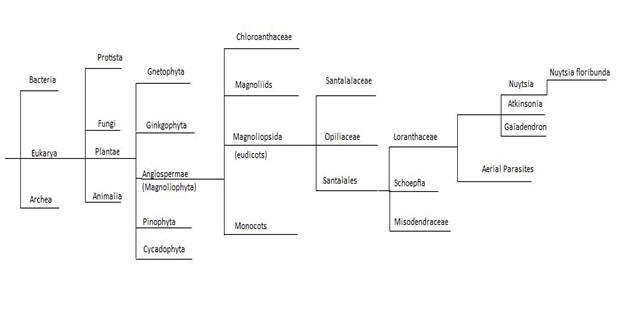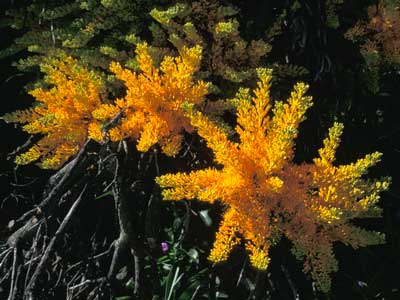Western Australian Christmas Tree
(Nuytsia floribunda)
Classification of Nuytsia floribunda
Scientific Name: Nuytsia Floribunda
Common Name: Western Australian Christmas tree
Derivation of Name: The Latin name Nuytsia comes from Pieter Nuyts. Nuyts was a member of the Council of Dutch Indies and a 17th century explorer in Southwestern Australia. Then the word floribunda comes from the Latin word floribundus meaning profusely flowering (ANPSA, 2007).
Where does Nuytsia floribunda fit
in the big picture of Life?
Domain – Eukarya
Kingdom – Plantae
Phylum – Angiospermae
Class – Magnoliopsida
Order – Santalales
Family – Loranthaceae
Genus – Nuystia
Species – Nuytsia floribunda
Why There?
Eukarya:
Nuytsia floribunda is in the Domain Eukarya opposed to Bacteria and Archea because it is comprised of multiple complex eukaryotic cells. These eukaryotic cells include a true nucleus, membrane bound organelles, larger ribosomes, and linear chromosomes.
Plantae:
Kingdom Plantae, also known as the plants include this organism because it withholds all the characteristics of a plant and a plant cell including photosynthetic qualities, chloroplasts, and cellulose cell walls.
Angiospermae:
Nuytsia floribunda is in the Phylum Angiospermae because it is an angiosperm. An angiosperm is classified as a plant that contains flowers and a seed protected by a fruit covering.
Magnoliopsida:
Class Magnoliopsida or more specifically sub-class Rosidae is where the tree is then placed because it is a eudicotic plant. This means that it has web-like leaves, tricoplate pollen, and more complex stems. This class also includes showy flowers which Nuytsia floribunda has along with as many as or more stamens than petals (Reed, 2009).
Santalales:
Nuytsia Floribunda is then narrowed down into the order of Santalales. The tree is put in this order because all plants in this order are parasitic to some degree, and in this organisms case it is hemi-parasitic because it attaches to the roots of other plants for nutrients.
Loranthaceae:
The organism is then placed in the family Loranthaceae. This family includes all the mistletoe species. Theses organisms contain hermaphroditic flowers, which means that they can pollinate themselves.
Nuytsia:
Starting to bring things to full circle, the Western Australian Christmas Tree is put in the genus Nuytsia, then turning into the species Nuytsia floribunda because of all the above classifications along with it being native to southwestern Australia and being tree up to 10 meters high with rough, grey-brown bark containing yellow and orange flowers from October to January (DEC, 2009).
Phylogenetic Tree

How is Nuytsia floribunda Classified?
The phylogenetic tree above is based on molecular evidence, including the number of chromosomes, along with basic morphological structures and their functions. With that information, this phylogenetic tree represents Nuytsia floribunda’s closest relatives along with where the organism fits in the big picture of life. Nuytsia floribunda is most closely related to two other genera, Atkinsonia and Gaiadendron. All three of these having hemi-parasitic root systems. The other 86 genera of the family Loranthaceae are aerial parasites. The family Loranthaceae is known for its parasitic mistletoe plants along with its hermaphroditic flowers.
The family Loranthaceae is then included in the order Santalales. Santalales includes all of the mistletoes, which are parasitic. Parasitism in the mistletoes has then evolved independently five times in the order, and only nine times in the entire Plant kingdom (Job, 1969). The order Santalales belongs to the class Magnoliopsida or the Eudicots, meaning a more complex vascular system along with web-like leaves. The class is then broadened into the Phylum Angiospermae, meaning that the plants contain flowers and fruit covered seeds unlike its close relatives, the Gymnosperms. To put the organism in the broadest categories, Nuytsia floribunda belongs to the kingdom Plantae because of its plant like components including xylem, phloem, chloroplasts, etc. Continuing on into the domain Eukarya because it's obviously composed of eukaryotic cells.
